Grain-Size Analysis of Middle Cretaceous Sandstone Reservoirs, the Wasia Formation, Riyadh Province, Saudi Arabia
Abstract
1. Introduction
2. Materials and Methods
- -
- The inclusive graphic mean () is a descriptive measure that represents the grain-size distribution of sediments.
- -
- The inclusive graphic standard deviation (), commonly known as grain-size sorting, measures the degree of scattering of grain-size around the mean size.
- -
- The inclusive graphic skewness () is a descriptive parameter that displays the symmetry of the grain-size distribution.
- -
- The graphic kurtosis () represents the sharpness of grain-size frequency curve that compares the sorting or spreading of the middle distribution section to the tail spread.
3. Results and Discussion
3.1. Grain-Size Statistics
3.2. Grain-Size Parameters
3.3. Bivariate Plots of Statistical Parameters
3.4. Linear Discriminate Function (LDF)
3.5. Facies Analysis
3.6. Passega Diagram (C-M Pattern)
3.7. Visher Diagram
| Bed | Facies (Thickness) | Sedimentary Structure | Strike and dip | Depositional environment | Photo | |
| 14 | Yellowish-gray calcareous sandstone (3 m) | Massive sandstone | Shallow marine (Shallow subtidal) |  | Transitional Environment: continental to shoreline to marine to shallow marine (shallow subtidal) | |
| 13 | Fine-grained sandstone (2.5 m) | Large-scale trough crossbedded | Strike 134° SE Dip 31° N | Aeolian |  | |
| 12 | Yellowish-gray fine-grained sandstone (2 m) | Bedded, occasionally pebbles at the base of each | Aeolian |  | ||
| 11 | Fine-grained sandstone (1.5 m) | Thinly bedded—laminated | Aeolian |  | ||
| 10 | Yellowish-gray fine-grained sandstone (3 m) | Occasionally pebbles at the base of each bed | Aeolian |  | ||
| 9 | Fine to medium-grained sandstone (1 m) | Planar crossbedding | Strike 7° NW Dip 29° E | Aeolian |  | |
| 8 | Fine to medium-grained yellowish-gray sandstone (1.5 m) | Thinly bedded with a gradational contact | Marine |  | ||
| 7 | Fine-grained sandstone (2 m) | Laminated to thinly bedded with a gradational contact | Marine |  | ||
| 6 | Fine to medium-grained sandstone (1 m) | Gradational contacts with overlying / underlying beds | Marine |  | ||
| 5 | Medium-grained sandstone (0.5 m) | Planer crossbedding with pebbles at the base | Strike 328° NW Dip 28° E | Aeolian |  | |
| 4 | Pebbly coarse-grained sandstone (0.3 m) | Sharp contacts with overlying and the underlying units | Fluvial |  | ||
| 3 | Yellowish-white sandstone (3 m) | Large-scale planer and trough crossbedding | strike 350° NW Dip 18° E | Marine |  | |
| 2 | Yellowish-brown sandstone (1.2 m) | Tabular crossbedding with several crossbed sets | Crossbed strike 25°NW, dip 6° E Crossbed sets dip 24° E | Marine |  | |
| 1 | Grayish-brown pebbly coarse-grained sandstone (0.4 m) | The base of the section | Fluvial |  |
4. Conclusions
- To investigate the Wasia Formation outcrop, the grain-size analysis was conducted on its fourteen poorly cemented and friable sandstone beds, where a fresh representative sample was collected from each bed.
- The mean grain-size values show a large variation throughout the studied outcrop. The mean grain size of the bottom five beds is 0.75–1.89∅, while the values of the above nine beds range from 2.00 to 2.95∅. Such variation is to be expected because the grain size of the outcrop’s bottom section is larger than that of the upper section.
- Because the depositional environments of the bottom five beds of the studied outcrop were predominantly fluvial and marine, it was expected that such beds would have poor sorting and skewness variation, which is supported by the standard deviation results (average of 1.02∅). The depositional environments of the majority of the outcrop upper beds, on the other hand, were aeolian. As a result, well-sorting and symmetrical skewness were expected. The standard deviation and skewness of these beds, however, range from medium-sorted to medium-well-sorted and from coarse skewness to near symmetrical.
- Rolling and/or differing saltation levels were expected to transfer the sediments of the beds that were deposited in marine and fluvial environments. Aeolian sediments, on the other hand, were expected to be transported via suspension. The log probability plots and Passega diagram reveal that the majority of the sediments in the lower beds (fluvial and marine) were carried via rolling and two levels of saltation, whereas the majority of the sediments in the upper beds (mostly aeolian) were transported via suspension and one level of saltation.
- The LDF method confirms that the studied outcrop consists of aeolian, marine, and fluvial environments.
Supplementary Materials
Funding
Data Availability Statement
Conflicts of Interest
References
- Baiyegunhi, C.; Liu, K.; Gwavava, O. Grain size statistics and depositional pattern of the Ecca Group sandstones, Karoo Supergroup in the Eastern Cape Province, South Africa. Open Geosci. 2017, 9, 554–576. [Google Scholar] [CrossRef]
- Boggs, S., Jr.; Boggs, S. Petrology of Sedimentary Rocks; Cambridge University Press: Cambridge, UK, 2009. [Google Scholar]
- Edwards, A.C. Grain size and sorting in modern beach sands. J. Coast. Res. 2001, 17, 38–52. [Google Scholar]
- Kasim, S.A.; Ismail, M.S.; Ahmed, N. Grain size statistics and morphometric analysis of Kluang-Niyor, Layang-Layang, and Kampung Durian Chondong Tertiary Sediments, Onshore Peninsular Malaysia: Implications for paleoenvironment and depositional processes. J. King Saud Univ. Sci. 2023, 35, 102481. [Google Scholar]
- Blott, S.; Pye, K. Gradistat: A grain size distribution and statistics package for the analysis of unconsolidated sediments. Earth surface Processes and Landforms. 2001, 26, 1237–1248. [Google Scholar] [CrossRef]
- Bhat, M.; Chavadi, V.; Hegde, V. Morphological and textural characteristics of Kudle beach, Karnataka, central west coast of India. Geol. Soc. India 2002, 59, 125–131. [Google Scholar]
- Folk, R.L. A review of grain-size parameters. Sedimentology 1966, 6, 73–93. [Google Scholar] [CrossRef]
- Folk, R.L. Petrology of Sedimentary Rocks; Hemphill Publishing Company: Austin, TX, USA, 1980. [Google Scholar]
- Folk, R.L.; Ward, W.C. Brazos River bar [Texas]; A study in the significance of grain size parameters. J. Sediment. Res. 1957, 27, 3–26. [Google Scholar] [CrossRef]
- Friedman, G.M. Differences in size distributions of populations of particles among sands of various origins: Addendum to IAS Presidential Address. Sedimentology 1979, 26, 859–862. [Google Scholar] [CrossRef]
- Goswami, B.; Ghosh, D. Understanding the transportational and depositional setting of Panchet Formation, Purulia and Bankura districts of West Bengal, India—Evidence from grain size analysis. Front. Earth Sci. 2011, 5, 138–149. [Google Scholar] [CrossRef]
- Kovács, J. Grain-size analysis of the Neogene red clay formation in the Pannonian Basin. Int. J. Earth Sci. 2008, 97, 171–178. [Google Scholar] [CrossRef]
- Kulkarni, S.J.; Deshbhandari, P.G.; Jayappa, K. Seasonal variation in textural characteristics and sedimentary environments of beach sediments, Karnataka Coast, India. Aquat. Procedia 2015, 4, 117–124. [Google Scholar] [CrossRef]
- Passega, R. Texture as characteristic of clastic deposition. AAPG Bull. 1957, 41, 1952–1984. [Google Scholar]
- Passega, R. Grain size representation by CM patterns as a geologic tool. J. Sediment. Res. 1964, 34, 830–847. [Google Scholar] [CrossRef]
- Pettijohn, F.J.; Potter, P.E.; Siever, R. Sand and Sandstone; Springer: Berlin/Heidelberg, Germany, 2012. [Google Scholar]
- Rajganapathi, V.; Jitheshkumar, N.; Sundararajan, M.; Bhat, K.; Velusamy, S. Grain size analysis and characterization of sedimentary environment along Thiruchendur coast, Tamilnadu, India. Arab. J. Geosci. 2013, 6, 4717–4728. [Google Scholar] [CrossRef]
- Sahu, B.K. Depositional mechanisms from the size analysis of clastic sediments. J. Sediment. Res. 1964, 34, 73–83. [Google Scholar]
- Skaberne, D. Interpretation of depositional environment based on grain size distribution of sandstones of the Val Gardena Formation in the area between Cerkno and Smrečje, Slovenia. Geologija 1996, 39, 193–214. [Google Scholar] [CrossRef]
- Visher, G.S. Grain size distributions and depositional processes. J. Sediment. Res. 1969, 39, 1074–1106. [Google Scholar]
- Boggs, S. Principles of Sedimentology and Stratigraphy; Pearson: London, UK, 2012. [Google Scholar]
- Friedman, G.M. Distinction between dune, beach, and river sands from their textural characteristics. J. Sediment. Res. 1961, 31, 514–529. [Google Scholar]
- Sagoe, K.-M.; Visher, G.S. Population breaks in grain-size distributions of sand; a theoretical model. J. Sediment. Res. 1977, 47, 285–310. [Google Scholar]
- Al-Furaih, A.A. Middle Cretaceous (Cenomanian Ostracoda from the Wasia Formation of Saudi Arabia. Univ. Kans. Paleontol. Contrib. 1983, 1–6. Available online: https://kuscholarworks.ku.edu/bitstream/handle/1808/3711/paleo.paper.108.pdf;sequence=1 (accessed on 23 January 2023).
- Soliman, F.; Al Shamlan, A. Review on the geology of the Cretaceous sediments of the Rub’al-Khali, Saudi Arabia. Cretac. Res. 1982, 3, 187–194. [Google Scholar] [CrossRef]
- Alsharhan, A.; Nairn, A. A review of the ctretaceous formations in the Arabian Peninsula and gulf: Partii. mid-cretaceous (wasia group) stratigraphy and paleogeography. J. Pet. Geol. 1988, 11, 89–112. [Google Scholar] [CrossRef]
- Khan, A.M.; Al-Juhani, S.G.; Abdul, S. Digital viscoelastic seismic models and data sets of central Saudi Arabia in the presence of near-surface karst features. J. Seism. Explor. 2020, 29, 15–28. [Google Scholar]
- El-Khayal, A. Occurrence of a characteristic Wealden fern (Weichselia reticulata) in the Wasia Formation, central Saudi Arabia. Scr. Geol. 1985, 79, 75–88. [Google Scholar]
- Steineke, M.; Bramkamp, R.; Sander, N. Stratigraphic relations of Arabian Jurassic oil. In Habitat of Oil; Weeks, L.G., Ed.; the American Association of Petroleum Geologist: Tulsa, Oklahoma, USA, 1958; pp. 1294–1329. [Google Scholar]
- Sharief, F.A.; Magara, K.; Abdulla, H.M. Depositional system and reservoir potential of the Middle Cretaceous Wasia Formation in central—Eastern Arabia. Mar. Pet. Geol. 1989, 6, 303–315. [Google Scholar] [CrossRef]
- Powers, R.; Ramirez, L.; Redmond, C.; Elberg, E. Geology of the Arabian Peninsula; U.S. Geological Survey: Washington, DC, USA, 1966.
- Entsminger, L.D. Sedimentary Response to Tectonic and Eustatic Changes: An Example from the Mid-Cretaceous Wasia Formation, Saudi Arabia. In Proceedings of the Middle East Technical Conference and Exhibition, Manama, Bahrain, 9–12 March 1981. [Google Scholar]
- Alfaifi, H.J.; Abdelfatah, M.S.; Abdelrahman, K.; Zaidi, F.K.; Ibrahim, E.; Alarifi, N.S. Groundwater management scenarios for the Biyadh-Wasia aquifer systems in the eastern part of Riyadh region, Saudi Arabia. J. Geol. Soc. India 2017, 89, 669–674. [Google Scholar] [CrossRef]
- Herlambang, A.; John, C.M. Fluid flow evolution revealed by carbonate clumped isotope thermometry along the fractures in a complex salt dome setting: Study case (Jebel Madar, Oman). Mar. Pet. Geol. 2023, 152, 106220. [Google Scholar] [CrossRef]
- Sharland, P.; Archer, R.; Casey, D.; Davies, R.; Hall, S.; Heward, A.; Horbury, A.; Simmons, M. Sequence stratigraphy of the Arabian Plate. GeoArabia 2001, 2, 1. [Google Scholar]
- Awadh, S.M.; Al-Mimar, H.; Yaseen, Z.M. Groundwater availability and water demand sustainability over the upper mega aquifers of Arabian Peninsula and west region of Iraq. Environ. Dev. Sustain. 2021, 23, 1–21. [Google Scholar] [CrossRef]
- Nairn, A.; Alsharhan, A. Sedimentary Basins and Petroleum Geology of the Middle East; Elsevier: Amsterdam, The Netherlands, 1997. [Google Scholar]
- Davies, R.B.; Casey, D.M.; Horbury, A.D.; Sharland, P.R.; Simmons, M.D. Early to mid-Cretaceous mixed carbonate-clastic shelfal systems: Examples, issues and models from the Arabian Plate. GeoArabia 2002, 7, 541–598. [Google Scholar] [CrossRef]
- AlGeer, R. Origin of the Mid Cretaceous Heavy Oils from the Safaniya Sandstone Reservoir (Wasia Formation), Saudi Arabia. Master’s Thesis, University of Calgary, Calgary, AL, Canada, 2014. [Google Scholar]
- Newell, K.; Hennington, R. Potential Petroleum Source Rock Deposition in the Middle Cretaceous Wasia Formation, Rub’Al Khali, Saudi Arabia. In Proceedings of the Middle East Oil Technical Conference and Exhibition, Manama, Bahrain, 14–17 March 1983. [Google Scholar]
- Hussain, M.; El Hassan, W.M.; Abdulraheem, A. Controls of grain-size distribution on geomechanical properties of reservoir rock—A case study: Cretaceous Khafji Member, Zuluf Field, offshore Arabian Gulf. Mar. Pet. Geol. 2006, 23, 703–713. [Google Scholar] [CrossRef]
- Shabani, F.; Amini, A.; Tavakoli, V.; Honarmand, J.; Gong, C. 3D forward stratigraphic modeling of the Albian succession in a part of the northeastern margin of the Arabian Plate and its implications for exploration of subtle traps. Mar. Pet. Geol. 2022, 145, 105880. [Google Scholar] [CrossRef]
- Krumbein, W.; Monk, G. Permeability as a function of the size parameters of unconsolidated sand. Trans. AIME 1943, 151, 153–163. [Google Scholar] [CrossRef]
- Ajaegwu, N.E.; Okoro, A.U.; Obiadi, I.I.; Anakwuba, E.K.; Onuba, L.N. Facies Associations and Successions in Amaseri Sandstones, Southern Benue Trough, Nigeria: Implications for Interpretation of Depositional Environments and Palaeogeography. Facies 2015, 5, 25–41. [Google Scholar]
- Friedman, G.M. Dynamic processes and statistical parameters compared for size frequency distribution of beach and river sands. J. Sediment. Res. 1967, 37, 327–354. [Google Scholar]
- Tijani, M.N.; Nton, M.E. Hydraulic, textural and geochemical characteristics of the Ajali Formation, Anambra Basin, Nigeria: Implication for groundwater quality. Environ. Geol. 2009, 56, 935–951. [Google Scholar] [CrossRef]
- Yang, H.; Shi, C. Sediment grain-size characteristics and its sources of ten wind-water coupled erosion tributaries (the Ten Kongduis) in the Upper Yellow River. Water 2019, 11, 115. [Google Scholar] [CrossRef]
- Tijani, M.N.; Nton, M.E.; Kitagawa, R. Textural and geochemical characteristics of the Ajali Sandstone, Anambra Basin, SE Nigeria: Implication for its provenance. Comptes Rendus Geosci. 2010, 342, 136–150. [Google Scholar] [CrossRef]
- Moiola, R.; Weiser, D. Textural parameters; an evaluation. J. Sediment. Res. 1968, 38, 45–53. [Google Scholar]
- Baiyegunhi, T.L.; Liu, K.; Gwavava, O.; Baiyegunhi, C. Textural characteristics, mode of transportation and depositional environment of the Cretaceous sandstone in the Bredasdorp Basin, off the south coast of South Africa: Evidence from grain size analysis. Open Geosci. 2020, 12, 1512–1532. [Google Scholar] [CrossRef]
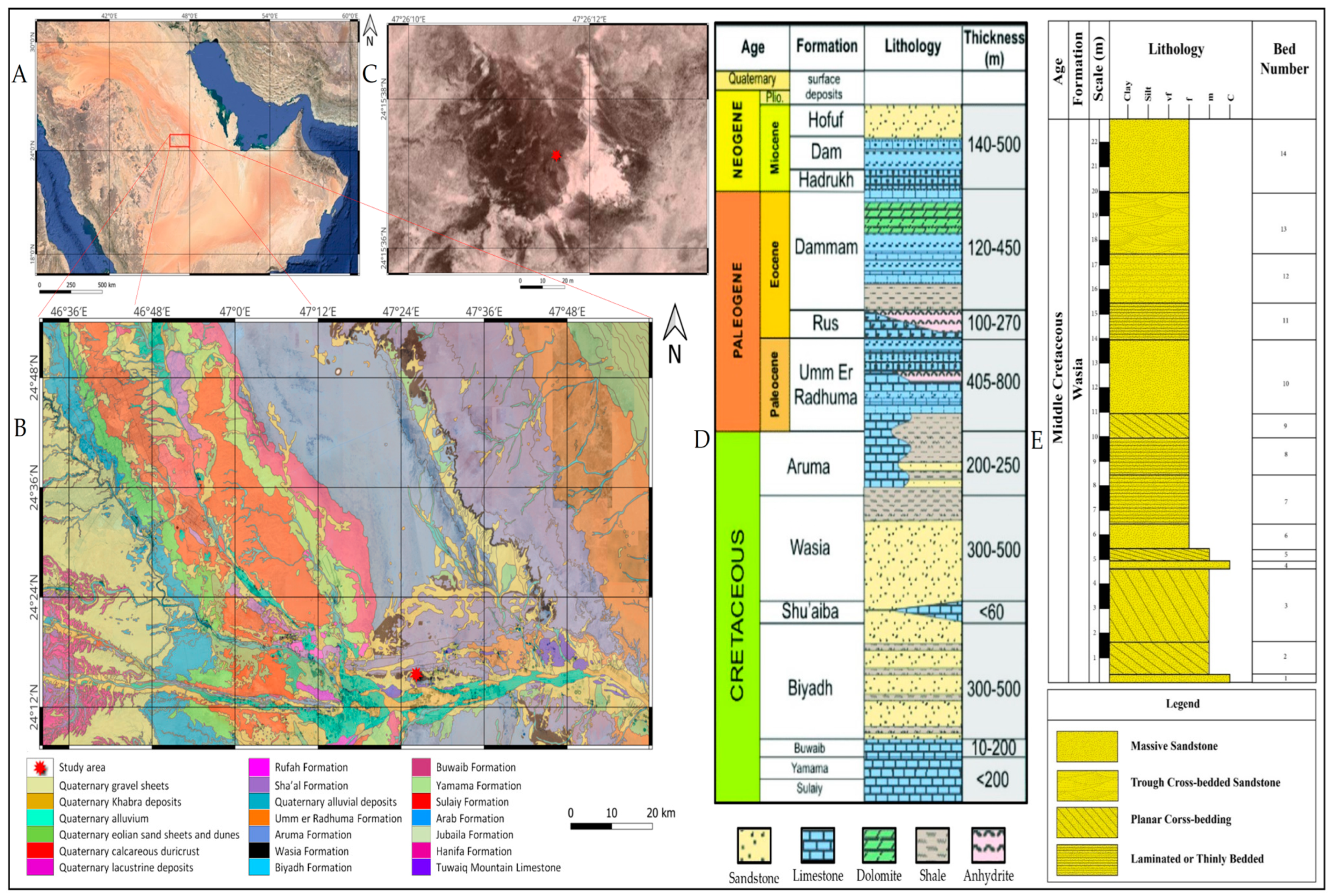
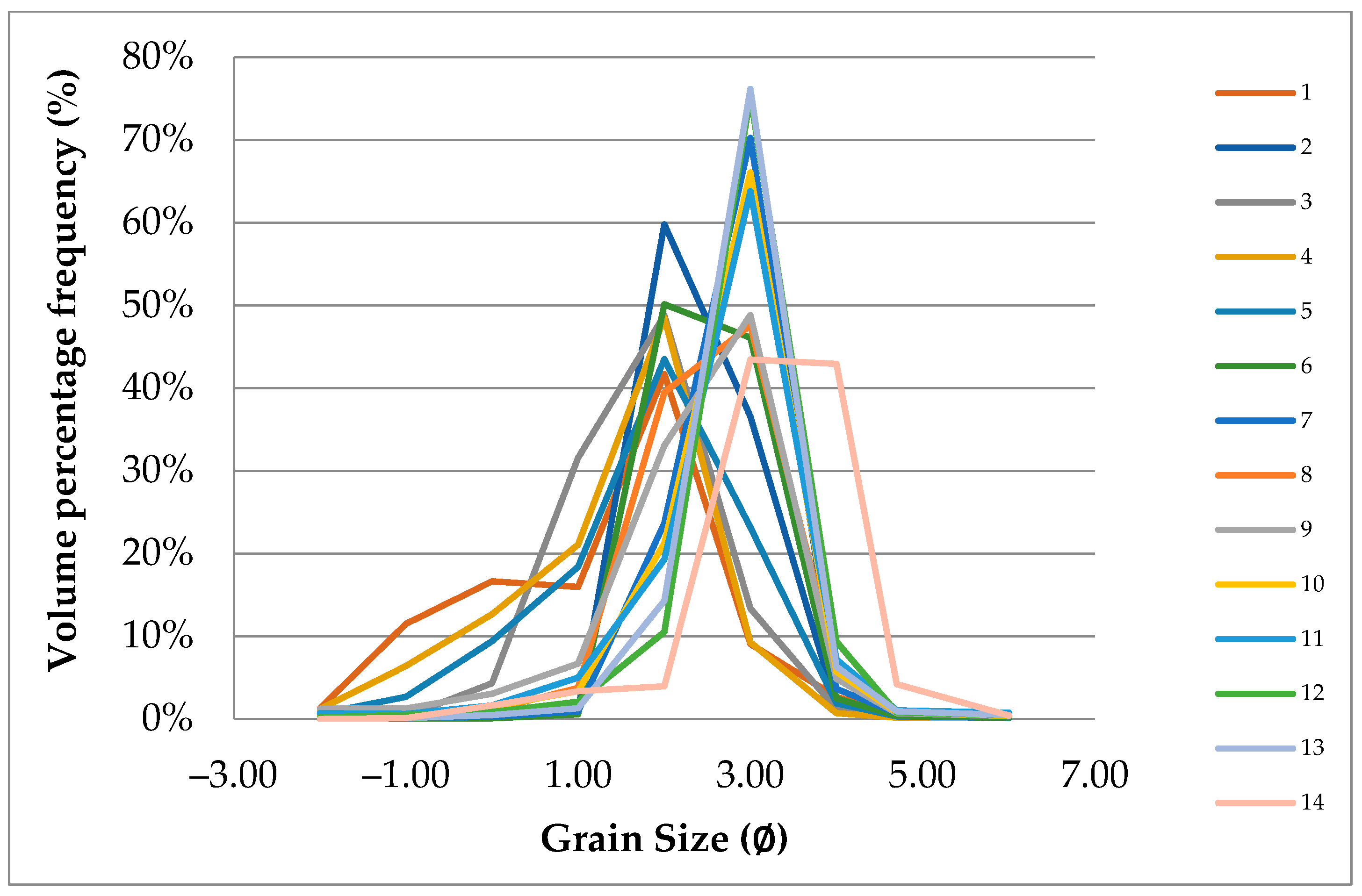
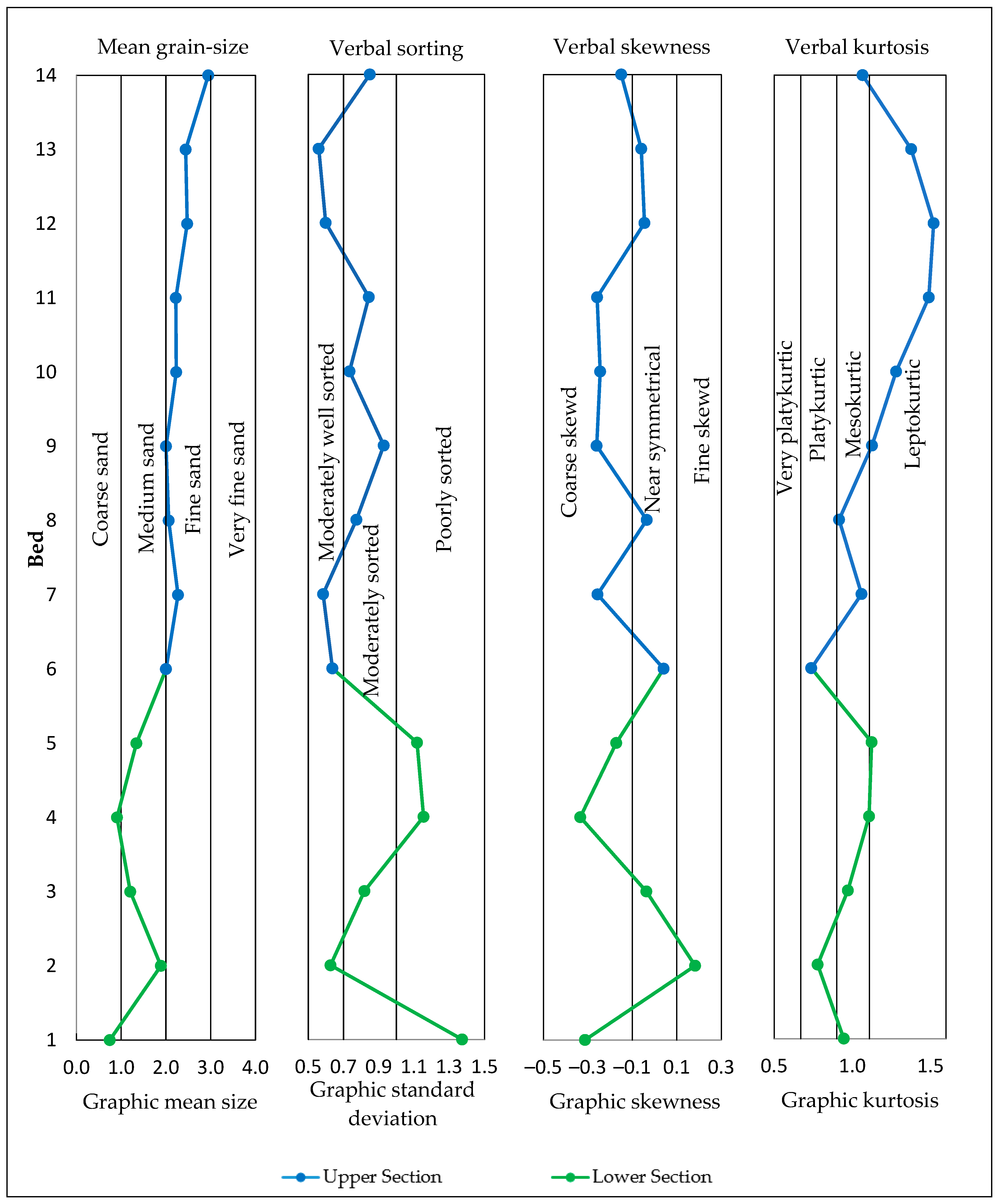
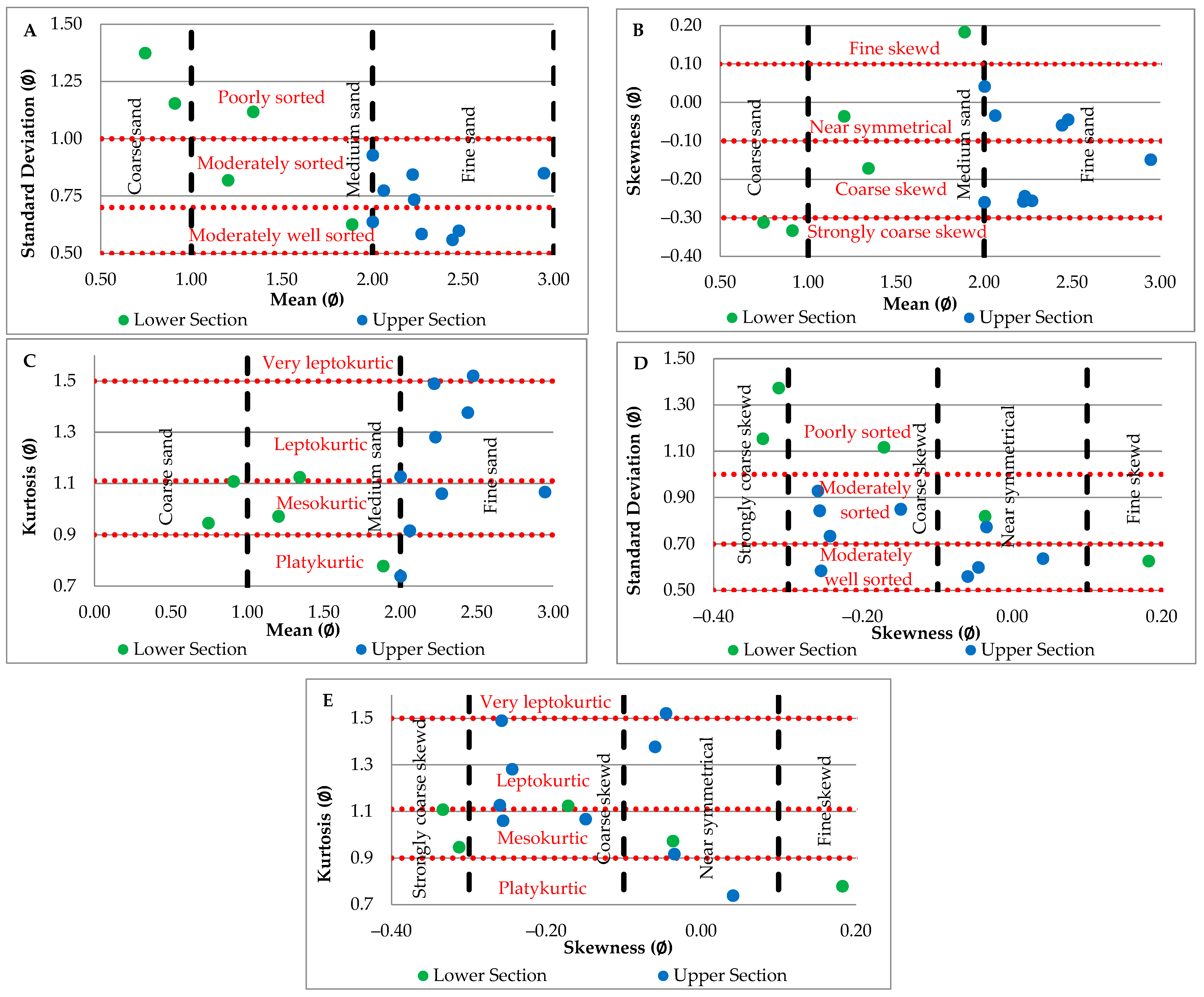
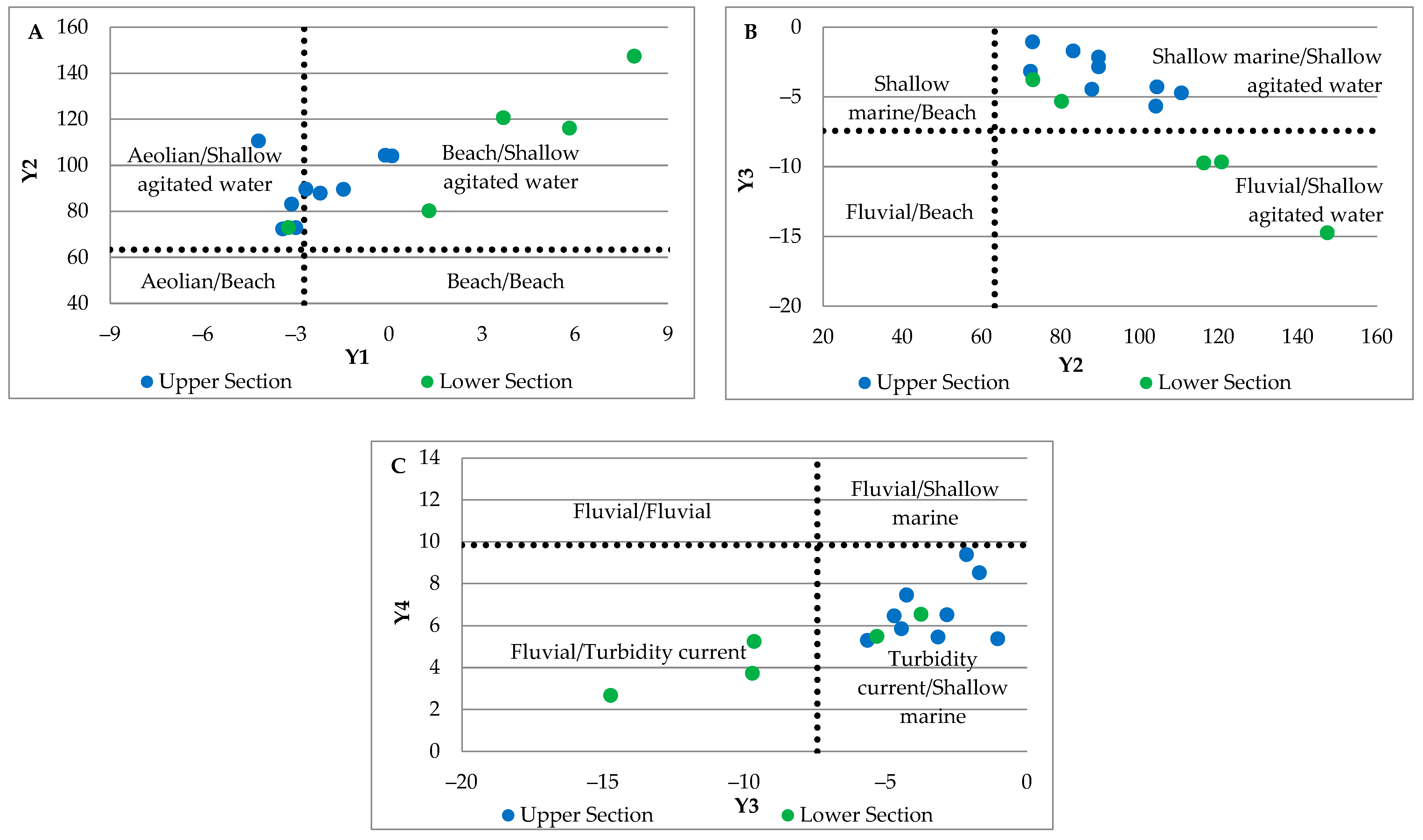
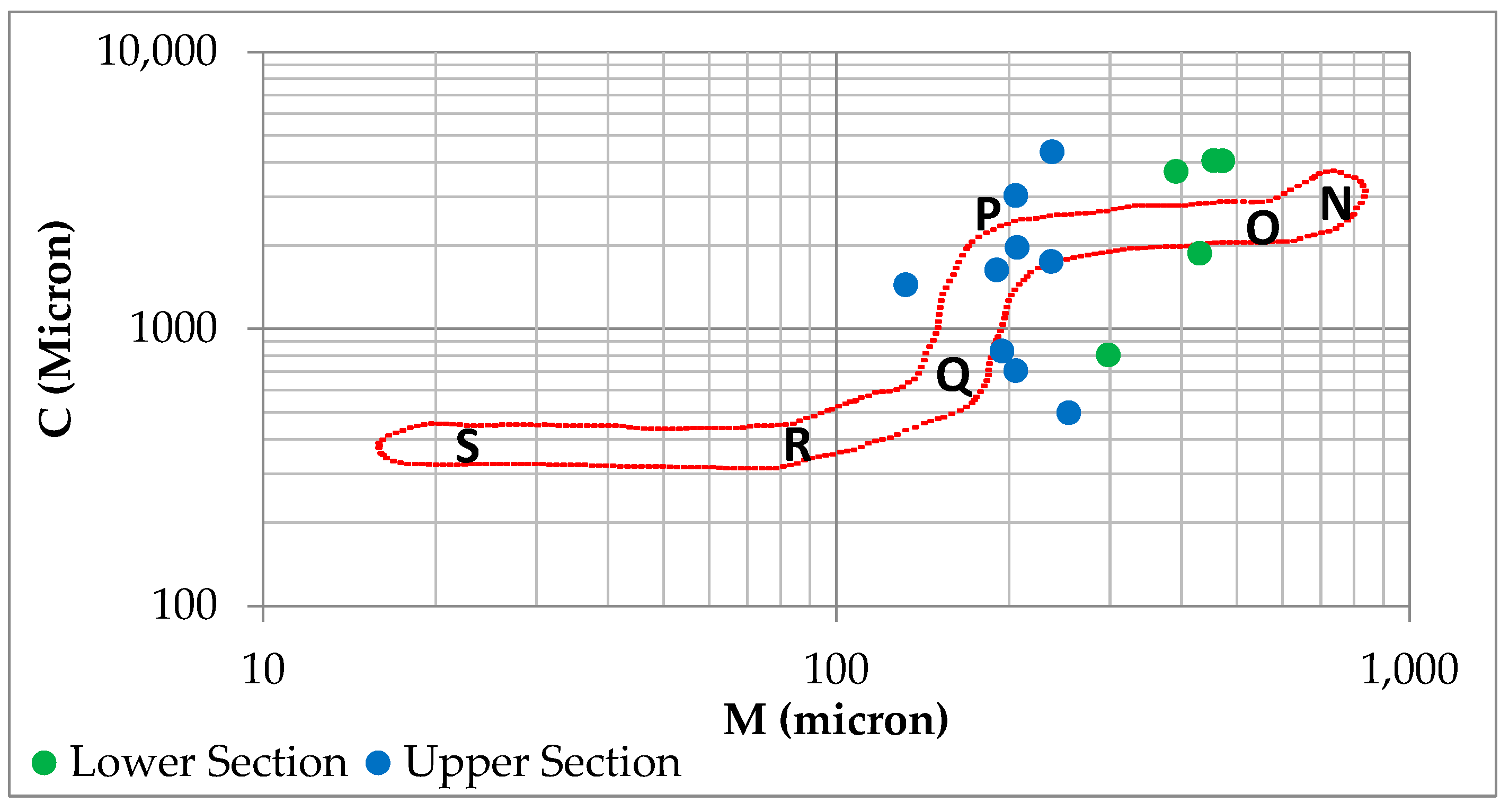
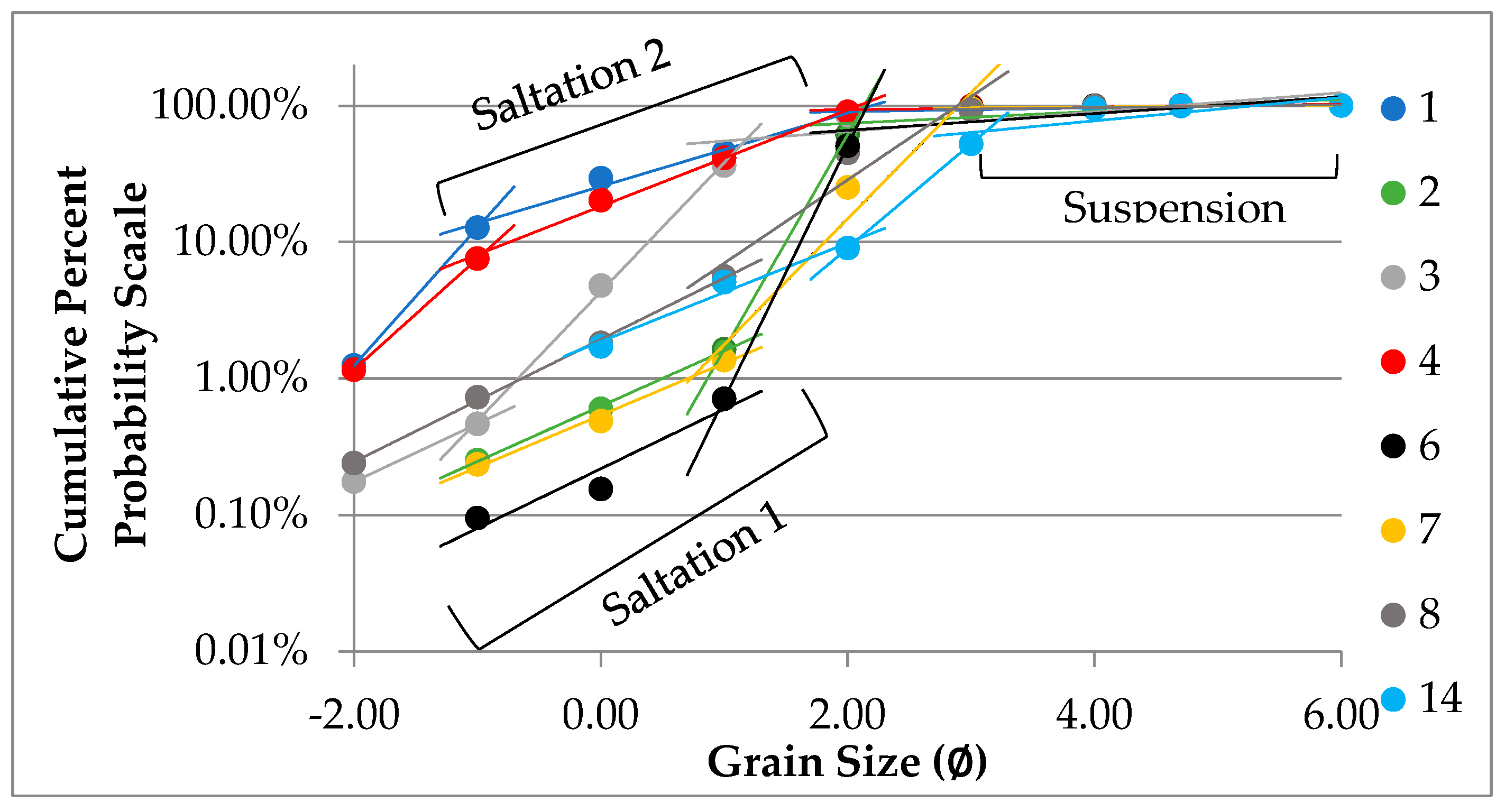
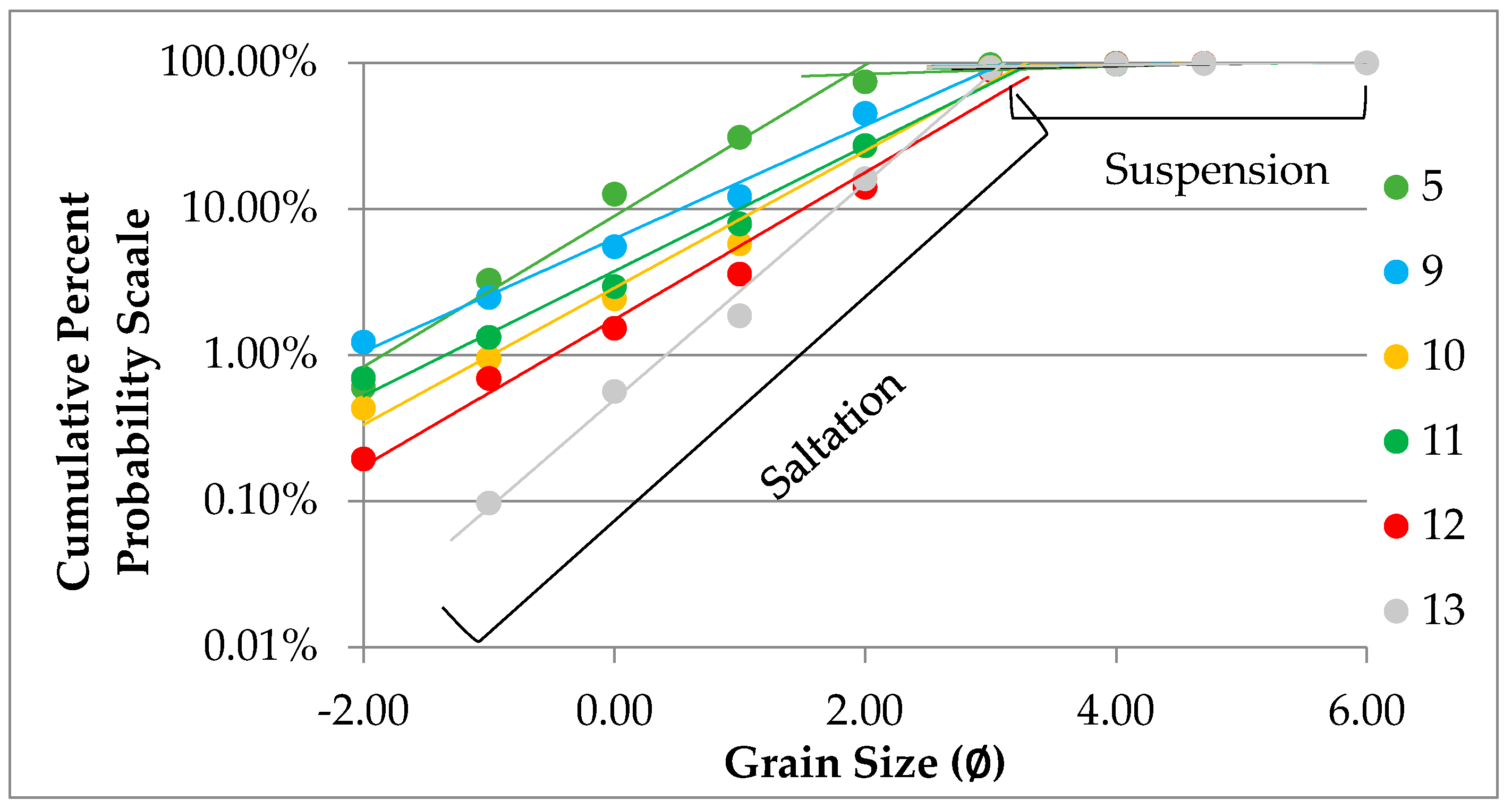
| Beds | Gravel | Sand | Mud | |||||||||
|---|---|---|---|---|---|---|---|---|---|---|---|---|
| 1 | −1.67 | −0.80 | −0.26 | 1.11 | 1.71 | 1.93 | 2.88 | 4042 | 472 | 12.7% | 86% | 1.3% |
| 2 | 1.06 | 1.24 | 1.39 | 1.81 | 2.37 | 2.62 | 2.92 | 805 | 298 | 0.3% | 99% | 0.5% |
| 3 | 0.01 | 0.36 | 0.64 | 1.28 | 1.79 | 1.98 | 2.74 | 1876 | 430 | 0.5% | 99% | 0.3% |
| 4 | −1.40 | −0.33 | 0.23 | 1.18 | 1.70 | 1.88 | 2.57 | 4050 | 455 | 7.6% | 92% | 0.3% |
| 5 | −0.82 | 0.18 | 0.67 | 1.44 | 2.02 | 2.41 | 2.88 | 3700 | 391 | 3.3% | 96% | 0.4% |
| 6 | 1.09 | 1.30 | 1.48 | 1.98 | 2.52 | 2.72 | 2.96 | 499 | 254 | 0.1% | 99% | 0.6% |
| 7 | 1.15 | 1.62 | 2.00 | 2.36 | 2.71 | 2.84 | 3.00 | 707 | 206 | 0.2% | 99% | 1.1% |
| 8 | 0.85 | 1.26 | 1.49 | 2.10 | 2.63 | 2.82 | 3.39 | 1750 | 237 | 0.7% | 98% | 1.3% |
| 9 | −0.17 | 1.12 | 1.39 | 2.10 | 2.61 | 2.79 | 3.19 | 4363 | 238 | 2.5% | 96% | 1.1% |
| 10 | 0.77 | 1.48 | 1.90 | 2.35 | 2.73 | 2.86 | 3.33 | 1968 | 207 | 1.0% | 98% | 1.2% |
| 11 | 0.41 | 1.42 | 1.89 | 2.36 | 2.75 | 2.89 | 3.55 | 3031 | 205 | 1.3% | 97% | 1.8% |
| 12 | 1.13 | 2.03 | 2.14 | 2.48 | 2.81 | 2.93 | 3.60 | 1632 | 190 | 0.7% | 98% | 1.2% |
| 13 | 1.22 | 1.99 | 2.12 | 2.44 | 2.77 | 2.89 | 3.43 | 831 | 194 | 0.1% | 99% | 1.4% |
| 14 | 0.98 | 2.16 | 2.37 | 2.94 | 3.52 | 3.73 | 3.99 | 1442 | 132 | 0.1% | 95% | 4.6% |
| Beds | Sizing | Sorting | Verbal Skewness | Verbal Kurtosis | ||||
|---|---|---|---|---|---|---|---|---|
| 1 | 0.75 | CS | 1.37 | PS | −0.31 | SCSK | 0.946 | M |
| 2 | 1.89 | MS | 0.63 | MWS | 0.18 | FSK | 0.778 | P |
| 3 | 1.20 | MS | 0.82 | MS | −0.04 | NS | 0.972 | M |
| 4 | 0.91 | CS | 1.15 | PS | −0.33 | SCSK | 1.107 | M |
| 5 | 1.34 | MS | 1.12 | PS | −0.17 | CSK | 1.124 | L |
| 6 | 2.00 | FS | 0.64 | MWS | 0.04 | NS | 0.738 | P |
| 7 | 2.27 | FS | 0.58 | MWS | −0.26 | CSK | 1.060 | M |
| 8 | 2.06 | FS | 0.77 | MS | −0.03 | NS | 0.916 | M |
| 9 | 2.00 | FS | 0.93 | MS | −0.26 | CSK | 1.127 | L |
| 10 | 2.23 | FS | 0.73 | MS | −0.24 | CSK | 1.281 | L |
| 11 | 2.22 | FS | 0.84 | MS | −0.26 | CSK | 1.490 | L |
| 12 | 2.48 | FS | 0.60 | MWS | −0.05 | NS | 1.521 | VL |
| 13 | 2.44 | FS | 0.56 | MWS | −0.06 | NS | 1.377 | L |
| 14 | 2.95 | FS | 0.85 | MS | −0.15 | CSK | 1.067 | M |
| Sample | Discriminate Function | Environment of Deposition | ||||||
|---|---|---|---|---|---|---|---|---|
| Y1 | Y2 | Y3 | Y4 | Y1 | Y2 | Y3 | Y4 | |
| 1 | 7.91 | 147.47 | −14.74 | 2.68 | Aeolian | Shallow Agitated | Fluvial | Turbidity |
| 2 | −3.24 | 73.04 | −3.75 | 6.56 | Beach | Shallow Agitated | Shallow Marine | Turbidity |
| 3 | 1.29 | 80.26 | −5.31 | 5.50 | Aeolian | Shallow Agitated | Shallow Marine | Turbidity |
| 4 | 5.82 | 116.22 | −9.72 | 3.73 | Aeolian | Shallow Agitated | Fluvial | Turbidity |
| 5 | 3.69 | 120.71 | −9.66 | 5.26 | Aeolian | Shallow Agitated | Fluvial | Turbidity |
| 6 | −3.43 | 72.42 | −3.15 | 5.47 | Beach | Shallow Agitated | Shallow Marine | Turbidity |
| 7 | −3.01 | 72.96 | −1.04 | 5.39 | Beach | Shallow Agitated | Shallow Marine | Turbidity |
| 8 | −2.22 | 87.95 | −4.44 | 5.86 | Aeolian | Shallow Agitated | Shallow Marine | Turbidity |
| 9 | 0.09 | 104.10 | −5.65 | 5.31 | Aeolian | Shallow Agitated | Shallow Marine | Turbidity |
| 10 | −1.47 | 89.62 | −2.83 | 6.53 | Aeolian | Shallow Agitated | Shallow Marine | Turbidity |
| 11 | −0.12 | 104.41 | −4.26 | 7.47 | Aeolian | Shallow Agitated | Shallow Marine | Turbidity |
| 12 | −2.68 | 89.64 | −2.14 | 9.39 | Aeolian | Shallow Agitated | Shallow Marine | Turbidity |
| 13 | −3.15 | 83.18 | −1.69 | 8.52 | Beach | Shallow Agitated | Shallow Marine | Turbidity |
| 14 | −4.21 | 110.58 | −4.70 | 6.48 | Beach | Shallow Agitated | Shallow Marine | Turbidity |
Disclaimer/Publisher’s Note: The statements, opinions and data contained in all publications are solely those of the individual author(s) and contributor(s) and not of MDPI and/or the editor(s). MDPI and/or the editor(s) disclaim responsibility for any injury to people or property resulting from any ideas, methods, instructions or products referred to in the content. |
© 2023 by the author. Licensee MDPI, Basel, Switzerland. This article is an open access article distributed under the terms and conditions of the Creative Commons Attribution (CC BY) license (https://creativecommons.org/licenses/by/4.0/).
Share and Cite
Khalil, R. Grain-Size Analysis of Middle Cretaceous Sandstone Reservoirs, the Wasia Formation, Riyadh Province, Saudi Arabia. Sustainability 2023, 15, 7983. https://doi.org/10.3390/su15107983
Khalil R. Grain-Size Analysis of Middle Cretaceous Sandstone Reservoirs, the Wasia Formation, Riyadh Province, Saudi Arabia. Sustainability. 2023; 15(10):7983. https://doi.org/10.3390/su15107983
Chicago/Turabian StyleKhalil, Rayan. 2023. "Grain-Size Analysis of Middle Cretaceous Sandstone Reservoirs, the Wasia Formation, Riyadh Province, Saudi Arabia" Sustainability 15, no. 10: 7983. https://doi.org/10.3390/su15107983
APA StyleKhalil, R. (2023). Grain-Size Analysis of Middle Cretaceous Sandstone Reservoirs, the Wasia Formation, Riyadh Province, Saudi Arabia. Sustainability, 15(10), 7983. https://doi.org/10.3390/su15107983






